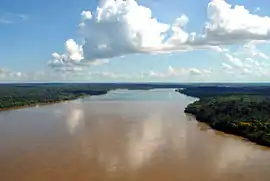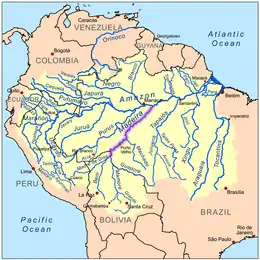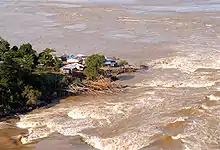Madeira River
The Madeira River (Portuguese: Rio Madeira [ˈʁi.u mɐˈdejɾɐ]) is a major waterway in South America. It is estimated to be 1,450 km (900 mi) in length, while the Madeira-Mamoré is estimated near 3,250 km (2,020 mi)[4] or 3,380 km (2,100 mi) in length depending on the measuring party and their methods. The Madeira is the biggest tributary of the Amazon, accounting for about 15% of the water in the basin.[5] A map from Emanuel Bowen in 1747, held by the David Rumsey Map Collection, refers to the Madeira by the pre-colonial, indigenous name Cuyari.[6]
The River of Cuyari, called by the Portuguese Madeira or the Wood River, is formed by two great rivers, which join near its mouth. It was by this River, that the Nation of Topinambes passed into the River Amazon.
| Madeira River | |
|---|---|
 The river in the outskirts of Porto Velho | |
 Map of the Madeira River watershed | |
| Etymology | Portuguese, "wood river" |
| Location | |
| Country | Bolivia, Brazil |
| Cities | Nova Olinda do Norte, Borba, Novo Aripuanã, Manicoré, Humaitá, Porto Velho |
| Physical characteristics | |
| Source | Confluence of Beni and Mamoré[1][2] |
| • location | Near Guayaramerín, Bolivia |
| • coordinates | 10°38′19″S 65°39′20″W |
| • elevation | 180 m (590 ft) |
| Mouth | Amazon River |
• location | Amazonas, Brazil |
• coordinates | 3°22′32″S 58°46′23″W |
• elevation | 40 m (130 ft) |
| Length | 1,450 km (900 mi)[3] |
| Basin size | 1,376,000 km2 (531,000 sq mi) |
| Discharge | |
| • location | near mouth |
| • average | 31,200 m3/s (1,100,000 cu ft/s) |
| • minimum | 2,346 m3/s (82,800 cu ft/s) |
| • maximum | 52,804 m3/s (1,864,800 cu ft/s) |
| Basin features | |
| River system | Amazon Basin |
| Tributaries | |
| • left | Beni River |
| • right | Mamoré River, Ji-Paraná River, Dos Marmelos River, Manicoré River, Mataurá River, Mariepauá River, Aripuanã River |

Climate
The mean inter-annual precipitations on the great basins vary from 75 to 300 cm (2.5–9.8 ft), the entire upper Madeira basin receiving 170.5 cm (5.6 ft). The greatest extremes of rainfall are between 49 and 700 cm (1.6–23 ft). Even just below the confluence that forms it, the Madeira is one of the largest rivers of the world, with a mean inter-annual discharge of 18,000 cubic metres per second (640,000 cu ft/s), i.e., 568 km3 (136 cu mi) per year, approximately half the discharge of the Congo River. On the further course towards the Amazon, the mean discharge of the Madeira increases up to 31,200 m3/s (1,100,000 cu ft/s).[7]
Course

Between Guajará-Mirim and the falls of Teotônio, the Madeira receives the drainage of the north-eastern slopes of the Andes from Santa Cruz de la Sierra to Cuzco, the whole of the south-western slope of Brazilian Mato Grosso and the northern slope of the Chiquitos sierras. In total this catchment area, which is slightly more than the combined area of all headwaters, is 850,000 km2 (330,000 sq mi),[8] almost equal in area to France and Spain combined. The waters flow into the Madeira from many large rivers, the principal of which, (from east to west), are the Guaporé or Iténez, the Baures and Blanco, the Itonamas or San Miguel, the Mamoré, Beni, and Madre de Dios or Mayutata, all of which are reinforced by numerous secondary but powerful affluents. The climate of the upper catchment area varies from humid in the western edge with the origin of the river's main stem by volume (Río Madre de Dios, Río Beni) to semi arid in the southernmost part with the Andine headwaters of the main stem by length (Río Caine, Río Rocha, Río Grande, Mamoré).
All of the upper branches of the river Madeira find their way to the falls across the open, almost level Mojos and Beni plains, 90,000 km2 (35,000 sq mi) of which are yearly flooded to an average depth of about one meter (3 ft) for a period of from three to four months.
From its source in the confluence of Madre de Dios and Mamoré rivers and downstream to Abuna River the Madeira flows northward forming border between Bolivia and Brazil. Below its confluence with the latter tributary the flow of river changes to north-eastward direction, inland of Rondônia state of Brazil. The section of the river from the border to Porto Velho has notable drop of bed and was not navigable. Before 2012 the falls of Teotônio and of San Antônio existed here, they had higher flow rate and bigger level drop than more famous Boyoma Falls in Africa. Currently these rapids are submerged by the reservoir of Santo Antônio Dam. Below Porto Velho the Madeira meanders north-eastward through the Rondônia and Amazonas states of north west Brazil to its junction with the Amazon.
The 283,117 hectares (2,800 km2; 1,100 sq mi) Rio Madeira Sustainable Development Reserve, created in 2006, extends along the north bank of the river opposite the town of Novo Aripuanã.[9] At its mouth is Ilha Tupinambaranas, an extensive marshy region formed by the Madeira's distributaries.
Navigation
The Madeira river rises more than 15 m (50 ft) during the rainy season, and ocean vessels may ascend it to the Falls of San Antonio, near Porto Velho, Brazil, 1,070 km (660 mi) above its mouth; but in the dry months, from June to November, it is only navigable for the same distance for craft drawing about 2 meters (7 ft) of water. The Madeira-Mamoré Railroad runs in a 365 km (227 mi) loop around the unnavigable section to Guajará-Mirim on the Mamoré River, but is not functional, limiting shipping from the Atlantic at Porto Velho.
Today, it is also one of the Amazon basin's most active waterways, and helps export close to four million tons of grains, which are loaded onto barges in Porto Velho, where both Cargill and Amaggi have loading facilities, and then shipped down the Madeira to the ports of Itacoatiara, near the mouth of the Madeira, just upstream on the left bank of the Amazon, or further down the Amazon, to the port of Santarem, at the mouth of the Tapajos River. From these two ports, Panamax-type ships then export the grains - mainly soy and corn - to Europe and Asia. The Madeira waterway is also used to take fuel from the REMAN refinery (Petrobras) in Manaus, state capital of Amazonas, to Porto Velho, from where the states of Acre, Rondônia and parts of Mato Grosso are supplied mainly with gasoline (petrol) refined in Manaus. Cargo barges also use the Madeira on the route between Manaus and Porto Velho, which is 1,225 km (760 mi)[10] along the Rio Negro, Amazon and Madeira, connecting Manaus' industrial district with the rest of Brazil, as Manaus is land-locked as far as logistics with the rest of the country are concerned, to bring in part of its raw materials, and export its produce to the major consumer centres of São Paulo and Rio de Janeiro. In 2012, the cargo amounted to 287,835 tons[10] (both directions). The total tonnage shipped in 2012 on the Madeira accounted to 5,076,014.[10]
Two large dams (see below) are under construction as part of the IIRSA regional integration project. The dam projects include large ship-locks capable of moving oceangoing vessels between the impounded reservoir and the downstream river. If the project is completed, "more than 4,000 km [2,500 mi] of waterways upstream from the dams in Brazil, Bolivia, and Peru would become navigable."[11]
Ecology

As typical of Amazonian rivers with the primary headwaters in the Andes, the Madeira River is turbid because of high sediment levels and it is whitewater, but some of its tributaries are clearwater (e.g., Aripuanã and Ji-Paraná) or blackwater (e.g., Manicoré).[12]
The Bolivian river dolphin, variously considered a subspecies of the Amazon river dolphin or a separate species, is restricted to the upper Madeira River system. It has been estimated that there are more than 900 fish species in the Madeira River Basin,[13] making it one of the freshwater systems in the world with the highest species richness.[14]
In popular culture
The river is the fifth title of the 1993/1999 Philip Glass album Aguas da Amazonia.
Dams
In July 2007, plans have been approved by the Brazilian Government to construct two hydroelectric dams on the Madeira River, the Santo Antônio Dam near Porto Velho and the Jirau Dam about 100 km upstream. Both the Jirau and Santo Antonio dams are run-of-the-river projects that do not impound a large reservoir. Both dams also feature some environmental re-mediation efforts (such as fish ladders). As a consequence, it has been suggested that there has not been strong environmental opposition to the implementation of the Madeira river complex.[15] Yet, if the fish ladders fail, "several valuable migratory fish species could suffer near-extinction as a result of the Madeira dams."[16] [17] There are also concerns with deforestation and pressure on conservation areas and indigenous peoples' territories.[18][19] The Worldwatch institute has also criticized the fast-track approval process for "kindler, gentler dams with smaller reservoirs, designed to lessen social and environmental impacts", claiming that no project should "fast-track the licensing of new dams in Amazonia and allow projects to circumvent Brazil's tough environmental laws".[16]
Languages
Indigenous languages of the upper Madeira River basin (in Brazil, Bolivia, and Peru):[20]
Note: † = extinct language
| Classification | Language(s) | Location | No. of speakers |
|---|---|---|---|
| Arawakan | Mojeño (2 dialects): Ignaciano, Trinitario-†Loretano | Mojos de Beni (San Ignácio, Isiboro-Sécure, Trinidad) | 2,000 |
| Arawakan | Terena: Terena, †Chané, dialects influenced by Guaikuru | southern Mato Grosso and southern Santa Cruz | 8,000 (?) |
| Arawakan | Paunaka | near Concepción (Santa Cruz) | 4 |
| Arawakan | Baure (3 dialects): Baure, †Muchojeone, †Paikoneka | savannas in northeastern Beni and forests in northern Santa Cruz | 40 |
| Arawakan | Parecí (3 dialects): Waimaré-Kaxiniti, Kozarini, Enawenê-Nawê | tributaries of the upper Juruena River and the upper Guaporé River (Mato Grosso) | 800 |
| Arawakan | †Sarave(ka) | Santa Cruz (border with Brazil) | 0 |
| Arawakan | Piro: Maniteneri, Iñapari | Pando and Piedras River (Peru) | 300 |
| Arawakan | †Lapaču / Apolista | Yungas de Apolo (La Paz) | 0 |
| Cariban | †Palmela | northeast of Beni, near the Guaporé River | 0 |
| Tupian | Tupi-Guarani (2 dialects): Guarayu, Kagwahib | from the San Pablo River (Ecuador) to the Paragúa River (Santa Cruz); Rondônia and Amazonas | 6,000 |
| Tupian | Sirionó, Yuki | between Trinidad and Santa Cruz | 600 |
| Tupian | Karitiana | east of Porto Velho | 170 |
| Tupian | Puruborá | São Miguel River (Rondônia) | 2 |
| Tupian | Mondé Suruí | Rondônia and Mato Grosso | 700 |
| Tupian | Mondé Gavião-Zoró, Cinta-Larga, Aruá, Salamãi | Rondônia and Mato Grosso | 1,800 |
| Tupian | Arara | Rondônia and Mato Grosso | 150 |
| Tupian | Makurap | east of Rondônia | 50 |
| Tupian | Tupari | Rondônia, coming from Mato Grosso | 150 |
| Tupian | Tsakirabiat, Akuntsu | east of Rondônia | 30 |
| Tupian | Wayoro | east of Rondônia | 10 |
| Tupian | †Kepkiriwat | east of Rondônia | 0 |
| Panoan | 2 dialects: Pakawara / †Karipuna, Chácobo / †Pakaa-Nova | lower Beni River, Yata River and Abunã River | 700 |
| Panoan | †Atsawaka, Yamiaka | Madre de Dios River (Peru) | 0 |
| Panoan | Kaxarari | Abunã River (Rondônia and Amazonas) | 100 |
| Panoan | Yaminawa | Acre and Pando | 500 |
| Tacanan | Araona | Madre de Dios River and Manuripi River | 81 |
| Tacanan | Esse’ Ejja | Madidi River | 500 |
| Tacanan | Cavineña | Beni River and Madidi River | 1,200 |
| Tacanan | Takana | between the upper Beni River and Peru | 1,800 |
| Tacanan | Maropa | upper Beni River | 5 |
| Chapacuran | Wari’ / “Pacaa-Nova” | Pacaás Novos River (Rondônia) | 1,300 |
| Chapacuran | Itene (Moré, Kautário) | Cautário River (Rondônia) and Bolivia | 20 |
| Chapacuran | Oro Win | upper Pacaás Novos River | 5 |
| Chapacuran | Wanyam (Miguelenho) | São Miguel River (Rondônia) | 2 |
| Chapacuran | †Tora, †Urupa | lower Machado River (Rondônia) | 0 |
| Chapacuran | †Chapacura proper, †Nãpeka | Rio Blanco (Santa Cruz) | 0 |
| Nambikwaran | Nambikwara, Northern | between the Cabixi River and Camararé River (Mato Grosso) | 20 |
| Nambikwaran | Nambikwara, Southern | between the upper Guaporé River and Juruena River (Mato Grosso) | 700 |
| Nambikwaran | Sabanê | near Vilhena (Mato Grosso) | 3 |
| Yabuti | Djeoromitxi | Rio Branco (Rondônia) | 40 |
| Yabuti | Arikapu (Mashubi) | Rio Branco (Rondônia) | 2 |
| Macro-Jê | Rikbaktsa (Canoeiro) | Juruena River (Mato Grosso) | 1,000 |
| isolate | Irantxe, Myky | Do Sangue River (Mato Grosso) | 300 |
| isolate | Aikanã (Masaka, Huari) | Corumbiara River and Apediá River (Rondônia) | 170 |
| isolate | Kanoê | Corumbiara River (Rondônia) | 5 |
| isolate | Kwaza (Koaiá) | Apediá River (Rondônia) | 25 |
| isolate | Canichana | San Pedro (Mamoré River) | 1 |
| isolate | Cayuvava | Exaltación (Mamoré River) | 1 |
| isolate | Itonama | northeast of Beni | 4 |
| isolate | Movima | Yacuma River (Beni) | 1,500 |
| isolate | Mosetén, Chimane | near San Borja (Beni) | 6,000 |
| isolate | Yuracare | from the Sécure River to the Ichilo River (Cochabamba) | 3,000 |
| isolate | Chiquitano | central Santa Cruz | 6,000 |
| isolate | Mura-Pirahã | middle Madeira River | 300 |
| isolate | †Matanawi | Castanha River / Roosevelt River | 0 |
| Harakmbet-Katukina | Harakmbet (Amarakaeri, Wachipaeri) | Madre de Dios River (Peru) | 650 |
References
- R. Ziesler and G.D. Ardizzone. LAS AGUAS CONTINENTALES DE AMERICA LATINA/THE INLAND WATERS OF LATIN AMERICA, Fishery Information, Data and Statistics Service. Fisheries Department FAO, Rome.
- Madeira, Visuotinė lietuvių enciklopedija
- Ziesler, R.; Ardizzone, G.D. (1979). "Amazon River System". The Inland waters of Latin America. Food and Agriculture Organization of the United Nations. ISBN 92-5-000780-9. Archived from the original on 21 October 2013.
- "Madeira (river)". Talktalk.co.uk (encyclopedia). Accessed May 2011.
- "Waters". Amazon Waters. Retrieved 22 January 2017.
- "Peru, Amazones. - David Rumsey Historical Map Collection". www.davidrumsey.com. Retrieved 16 April 2018.
- Seyler, Patrick; Laurence Maurice-Bourgoin; Jean Loup Guyot. "Hydrological Control on the Temporal Variability of Trace Element Concentration in the Amazon River and its Main Tributaries". Geological Survey of Brazil (CPRM). Retrieved 16 July 2013.
- Water and Salt Balances of the Bolivian Amazon, UNESCO
- RDS do Rio Madeira (in Portuguese), ISA: Instituto Socioambiental, retrieved 2016-09-01
- "Hidrovias Brasileiras" (PDF). Agencia Nacional de Transportes Aquaviarios (ANTAQ). Archived from the original (PDF) on 13 May 2014. Retrieved 15 January 2015.
- Maria del Carmen Vera-Diaz (2009). Effects of Energy and Transportation Projects on Soybean Expansion in the Madeira River Basin (PDF) (Report). Conservation Strategy Fund. Archived from the original (PDF) on October 12, 2007. Retrieved July 7, 2011.
- Fraser; Cardoso; Junqueira; Falcão; and Clement (2009). Historical ecology and dark earths in whitewater and blackwater landscapes: comparing the Middle Madeira and Lower Negro rivers. pp. 229-264 in: Woods; Teixeira; Lehmann; Steiner; WinklerPrins; and Rebellato, eds. Amazonian Dark Earths: Wim Sombroek's Vision. ISBN 978-1-4020-9031-8
- de Queiroz, L.J.; Torrente-Vilara, G.; Vieira, F.G.; Ohara, W.M.; Zuanon, J.; and Doria, C.R.C. (2013). Fishes of Cuniã Lake, Madeira River Basin, Brazil. Check List 9(3): 540–548
- Ekström, J. (23 December 2007) Hydroelectric dam constructions in Amazonas. Retrieved 6 February 2013.
- "Brazil Engineers a Critic-Proof Dam". Wall Street Journal. October 6, 2010. Retrieved 2 April 2011.
- "Greenwashing Hydropower". World Watch. Worldwatch Institute. 23 (1): 8–18. 2010.
- "Madeira River Basin: Hydropower dams in the heart of the Amazon". World Wildlife Fund Global. Archived from the original on 2 October 2012. Retrieved 7 July 2011.
- BBC News Online. 2007. Brazil gives Amazon dams go-ahead. 10 July. Available from: http://news.bbc.co.uk/2/hi/americas/6286804.stm. Accessed 16 July 2007.
- International, Survival. "Write a letter for dam-affected tribes of Brazil". www.survivalinternational.org. Retrieved 16 April 2018.
- Ramirez, Henri. 2006. As línguas indígenas do Alto Madeira: estatuto atual e bibliografia básica. Língua Viva vol. 01, n. 01. (PDF)
External links
- Beach, Chandler B., ed. (1914). . . Chicago: F. E. Compton and Co.
- The Amazon and Madeira Rivers: Sketches and Descriptions from the Note-Book of an Explorer from 1875